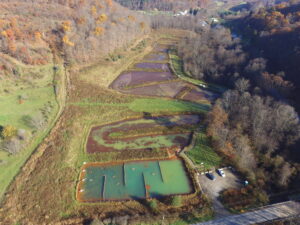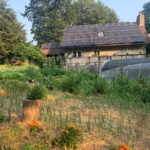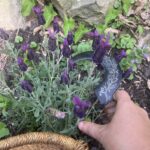There is a growing movement of people reconnecting to nature through the foraging and creation of wild pigments–pigments from the earth allow us to connect, grow and heal. This is so much more than foraging for colors from nature to use in art–rather, it is about developing deep conversations, connections, and rootedness in local landscapes, learning how to inhabit and be open to the messages of the living earth, addressing colonialism, and literally learning self-expression with the colors of the land. I shared an earlier experience when I first started learning to make my own pigments in this post–in the time since I’ve been deepening my practice of pigment foraging and pigment making here in the beautiful Allegheny mountains of Western Pennsylvania. As part of this ongoing exploration, I also joined a monthly earth pigment subscription called Ground Bright hosted by the Wild Pigment Project, which has been an incredible opportunity to connect with people doing this reconnective, healing, artwork all over the planet. After a year of being a subscriber, I reached out to contribute my own pigment offering–Tanoma Ochre, which was offered in December through Ground Bright. As part of sharing the pigment, I was asked to write the story of the pigment–and that story spiraled into a story of connectedness to the land, healing the land, and regeneration–many of the themes on this blog. Thus, I thought blog readers might enjoy what I wrote, so I’m sharing it here today.
——-
Growing up as a child in Western Pennsylvania, you lived every day with what pollution looked like. “Sulfur Creek” was the local creek, yellow, stinking, and lifeless, polluted by multiple mines discharging Acid Mine Drainage. People in this region, where over 3000 miles of waterways are polluted in similar manners, endure a legacy of pollution left by coal mines and the larger steel mill industry from over a century ago. These are the places our families and ancestors worked, lived, and died. These places, regardless of if we want them to, lodge in our own bones and blood. Most of our mines were already closed by the time the Mine Reclamation Act of 1978 was passed in the USA, which required mines to prevent waterway pollution. Unfortunately, because they were already closed and polluting, the act did nothing to stop the pollution of so many rivers and streams. Invariably as an artist growing up in this region, and later, choosing to return to it, I’ve worked such experiences into my work.

Here is Sulfur Creek, its literal name, which runs through small towns in Cambria County, PA, very close to where I grew up. Since I took this photo in 2016, grant supported cleanup efforts have begun, and the water is starting to clear. Cleanup of such a waterway can take decades, and it will be many years before the orange fully disappears.
Tanoma Ochre comes from the Tanoma Wetland site, where two different abandoned mine sites discharge their Acid Mine Draining (AMD), polluting local waterways. This constructed wetland prevents the discharge from flowing into TwoLick Creek and is supported by the Evergreen Conservancy, a community-led non-profit organization. Since the cleanup of this and one other site, the creek now is an excellent kayaking and fishing creek. All over Pennsylvania, we are seeing cleanup efforts like these taking place and we have freshwater mussels, otters, river snakes, and even freshwater turtles returning. The work has been slow, but it is critical and it is giving us all hope.

Here is a birds-eye view of the Tanoma wetland site, where the AMD remediation occurs. You can see the AMD coming in through two places in the first settling pool in the lower box-shaped green pool. This pool also offers the rich, orange-brown Tanoma ochre pigment that was shared with the Ground Bright Community. Here is Cindy, who is the president of the Evergreen Conservancy that oversees the Tanoma site, fishing for pigments and then laying them out to dry.

Here she dumps the pigments into a drying screen at the site, to dry in the sun, and then waits to be turned into something new.

We can see the pigment drying here with the beautiful, healing wetlands behind them. A chance for this pigment to be more than poison on the land—an chance for transformation to occur.

A lot of my own interest in pigments stems from these waste streams and my lifelong interaction with them. Growing up as a child, I often played in these creeks, smearing pigment on rocks to create designs. I didn’t understand what I was seeing then, but I certainly do now. But by working this waste pigment into my own art, as healing art, as art to help heal the land, I am able to bring that work of metaphysical healing into the forefront. That is, each piece of art that uses this waste that has been reclaimed is a powerful lesson in healing.

As an artist, I’ve learned how to work with the stories and pains of this landscape, transmuting them through art and words into healing. As a druid of almost 20 years, practicing nature spirituality, land healing, herbalism, and permaculture, I’ve also interwoven a spiritual practice that responds to these wounds and works toward balance and healing. All heal (Prunella Vulgaris), which comes from my Plant Spirit Oracle deck, includes the Tanoma Ochre in the browns of this piece, was specifically chosen because of this plant’s healing. This plant’s many folk names speak to the power of this artistic healing: the heart of the earth, woundwort, heal all. Another piece from the Plant Spirit Oracle, the Burdock Card, uses the Tanoma Ochre extensively to offer healing, rest, and hope.

Another part of this is coming to terms with my own ancestral legacy as a white colonizer of these lands. This ancestral legacy that I was born into, of waste streams, colonialization, and coal mining, is not one I’m proud of. The Susquehannock people, who were the original inhabitants of where I live and where the Tanoma site rests, were destroyed by white colonizers; I’m sure my ancestors were among them. These were the same ancestors that stripped Pennsylvania of 98% of its old-growth forests, and that opened up seams of coal in the ground that still poison our waterways. When I think about this heavy legacy of so much pain, I do the best thing I can to honor the lost ancestors of the land and the billions of non-human lives lost–by working to tend this broken and damaged land, healing and witnessing, and learning how to become a better ancestor.

I do this work as both an artist and a druid. I’ve started to write books to get the message out, in addition to my Druid’s Garden blog, where I’ve been writing on these topics for over 12 years (www.thedruidsgarden.com.) These included my first book Sacred Actions: Living the Wheel of the Year through Earth-Centered Sustainable Practices (Red Feather, 2021) and through my upcoming land healing book Healing Hands: Physical and Ritual Approaches to Healing the Earth (Red Feather, 2024). These works try to help us transition to more sustainable, regenerative living that does not depend on the extraction of fossil fuel, and that helps us help heal the damage humans have done. The potential cover of that book was painted in part with Tanoma Ochre in the design.
Here’s where it gets a bit complicated: druidry is, in itself, a colonized indigenous religion that many of us are working to bring back to life after literally millennia. I sit in the position of both someone who has been colonized and someone who also is part of a larger colonizer culture. I believe this perspective gives me some unique insights into these particular issues. We have a surprising number of indigenous people who have joined AODA, for example, and as the head of AODA, I work hard to make sure they are welcomed, supported, and that they have an honored place in our community.
Another thread of this weaving has been to create open-access foraging ethics and graphics, available to anyone who teaches or wants to learn to forage. I also teach wild food foraging classes in my local ecosystem, with these ethics, in the hopes that I can share a love of place and land that will grow and spread. No Tanoma ochre in these designs, but the spirit of Tanoma runs through them.
But somehow, these things never feel like enough. I look across this damaged landscape, and I can see the smoke from the coal plants in the distance. (And now, we have the terrible tragedy unfolding in East Palastine, Ohio, only about 103 miles from where I live). I drive and see the evidence of mountaintop removal, the recent deforestation, and the gas fracking wells that litter our otherwise beautiful landscape. I know that many underprivileged rural families’ livelihoods depend on these extractive activities, which makes it harder to fight them, especially when there is nothing else to take their place for employment. Those of us who are working to support the land and conserve our environment here often feel overwhelmed with the work that there is left to do…but every year, there are more people joining and waking up and realizing that meaningful change needs to happen. And that gives me hope. Maybe we can become good ancestors after all.
I am grateful for this opportunity to share the story of this pigment with you and share also about the legacy—and change—that so many of us are fighting for here in Western Pennsylvania. May we all walk the path of becoming good ancestors, living in honor of those who came before us, living in honor of those who came before us.




Powerful post. I deeply appreciate the work you do, as I’m sure does the natural world. The indigenous people I know say that a common belief on their ‘side’ is that this work requires a 300- (at least) plan, meaning that our collective really won’t come to fruition for many (& possibly many more) decades. But it’s Sacred Work, so…we do what must be done. Many blessings to you on your journey.